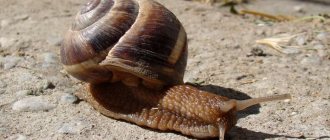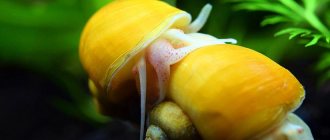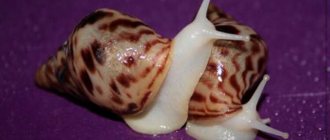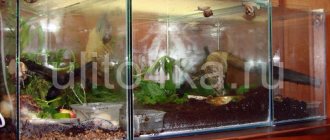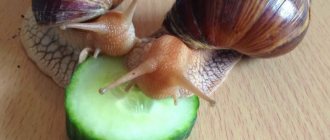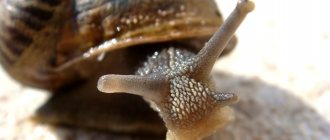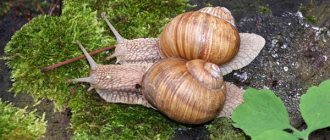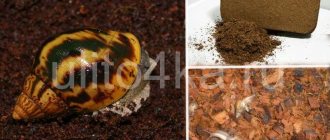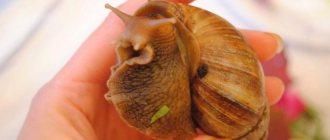Large mollusks Achatina are native to East Africa. For Russia and European countries these are exotic creatures, but for their native continent they are real pests of sugar cane crops. In their natural habitat, under favorable conditions of a tropical and humid climate, Achatina snails rapidly multiply, and huge herds of mollusks attack valuable agricultural crops.
At home, in a spacious, cozy container, snails grow quickly. With proper nutrition with healthy mineral supplements, mollusks reach sexual maturity within 6 months after birth.
Achatina are hermaphrodites. Each individual has male and female reproductive organs. In addition, there are two types of snail reproduction - egg laying and viviparity. In this article we will look at the first method of breeding snails. Read about viviparous Achatina snails in the article at the link.
How do snails reproduce if individuals do not enter into “love relationships” with representatives of their species for a long time? For the survival of the species, nature came up with a storage function. If a mature snail has already come into contact with another individual, it can store valuable sperm for 2 years and, if necessary, fertilize mature female eggs.
Recently, purchasing African Achatina snails as pets has become quite popular. If this exotic guest has already settled in your home, you are most likely already aware of the peculiarities of care, nutrition, growth and development of this pet. And, if a decision is made to have offspring, then it is necessary to create suitable conditions for the reproduction of Achatina snails. This process is not particularly complicated, but there are still some aspects worth considering for successful mating.
Reproductive system of the Achatina snail
The African snail belongs to the class of hermaphrodites, i.e. she has male and female reproductive organs. Achatina has no division into female and male individuals. A young small snail is masculine, an adult large snail is feminine. The readiness of Achatina to reproduce is indicated by the appearance of a white tubercle on the right side of the neck.
White bump on the snail's neck
Achatina snails are oviparous mollusks, but they are also viviparous.
This is the genital organ or genital opening, since the snail is hermaphrodite. This way she signals that she is ready to reproduce. The white spot stretches out and turns into an “arrow of love” - the male genital organ. The tubercle can go deep and turn into a funnel - into the female genital organ.
The mollusk reaches sexual maturity at 7-8 months, but the worse the conditions of detention, the later its reproductive age begins.
African domestic snails mating
During the first 6-7 months of life, mollusks actively grow and accumulate vitality to reproduce healthy offspring. At home, for normal development, pets need a comfortable temperature of 25-28 degrees, constant humidity up to 80%, a properly selected diet of fresh vegetables and fruits, and mandatory protein and calcium-containing mineral supplements.
If all conditions are met, six months after birth the mollusks will be ready to mate. The first sign of readiness for “intimate relationships” is a white bulge that appears on the right side of the gastropod’s head.
How do snails reproduce?
Reproduction of Achatina, like other species, begins with mating games. Individuals court each other, rub their heads and bite their necks. A smaller snail can climb onto the shell of a larger snail and settle there for several hours.
The genital organs of Achatina protrude and connect with each other. During the process of snail mating, fertilization occurs through penetration into the head cavity.
Mating of snails can last 2-3 hours, and sometimes longer. At this moment, mating Achatina should not be disturbed or separated. Otherwise, you can permanently damage the fragile reproductive system of mollusks.
How to create conditions for snail breeding
Proper care and comfortable living conditions allow you to grow a healthy snail and get viable offspring.
5 basic care tips
- The container containing the snail must be at least 15 liters;
- High-quality moist soil, filling 1/4 of the terrarium;
- Maintain constant temperature and humidity;
- Provide the snail with calcium and protein;
- Carry out daily and weekly cleaning of the terrarium.
A general cleaning of the terrarium or a complete replacement of the soil can serve as an incentive for reproduction in Achatina snails.
Selection and purchase of snails
All aquarists who have expressed a desire to have Achatina snails must first study the peculiarities of their behavior, maintenance and care. Only after this can you begin searching for and purchasing a gastropod. This event is quite complicated, as it involves considerable financial costs not only for the purchase of the snail, but also for its delivery.
As a rule, only experienced aquarists who know all the nuances of the process and can provide the mollusks with optimal conditions are involved in breeding these gastropods. In addition, they must cooperate with one of the pet stores, where they can check the health of the creatures and correctly determine their value.
When purchasing Achatina, it is important to consider the following nuances:
- It is not recommended to buy snails by hand, as in this case there is no guarantee of their healthy condition.
- You need to observe the behavior of the mollusk for several days and only if there are no obvious signs of any deviations can you buy them.
- It is important to take a closer look at the conditions of keeping Achatina in the pet store. If the requirements for lighting, ventilation or temperature are not met, it is better to refuse the purchase. Otherwise, you can buy a sick individual that has not yet shown obvious signs of illness.
- It is best to buy American or African Achatina with an officially documented pedigree. Only in this case can you be sure that there are no genetic abnormalities associated with their ancestors.
- Before purchasing, it is important to do a thorough inspection of the snail. Its shell should be uniform, without various flaws or defects.
- You should not take an Achatina that was born less than 2 months ago. The best option would be to purchase a gastropod at the age of 3 or 4 months.
Which snails should you not mate?
If you want to get healthy and viable snails, then do not mate snails from the same clutch, “parents” and “children,” “brothers” and “sisters.” Healthy and large mollusks from different families are allowed to reproduce. Mate snails of the same species and variety.
It should be noted that if you want to grow a large snail, then you should not rush into reproduction, since pregnancy completely inhibits the further development and growth of the mollusk. On the Internet you can find a recommendation that it is not advisable to mate a snail until it is one year old; Achatina is actively growing and developing.
See more similar articles:
Achatina Achatina: types of reproduction, nutrition and all about the tiger...
Reasons for the absence of offspring
It happens that all the conditions for reproduction are met, the terrarium is prepared, the snail is full of strength and ready for pregnancy, but there are no offspring . In this case, check the following nuances :
- Receiving individuals complete and balanced nutrition. The presence of additional feeding.
- One of the reasons may be the small thickness of the soil, for example, only 5 cm. In this case, the snail has nowhere to lay its eggs.
- Purity of the earth. If the soil is contaminated, Achatina will not be able to reproduce in it.
In addition, it is important to think about where to distribute future offspring. You cannot breed snails without a specific purpose. Experts advise deciding in advance why breeding is being done. Many people do this for sale or as a gift to friends and relatives.
How does the Achatina snail reproduce?
For mating, snails are placed in a separate container. If the snails are the same size, then fertilization occurs bilaterally, if the partners are different in size, then fertilization will be unilateral. The larger snail takes on the role of the female.
With age, the body of an adult Achatina produces more eggs than sperm.
A young snail produces more male sex cells than female ones, so for reproduction, a young one is added to adult snails.
The mating process in Achatina lasts about two hours. They gently touch their genitals, crawl and kiss each other. Whirling in such a love dance, sperm exchange and fertilization occur. Sperm is stored in the body of the mollusk for more than two years; under favorable conditions, the snail can lay eggs every month.
Caring for a pregnant snail
Snail pregnancy lasts differently for different species of Achatina, on average from one to two weeks. The snail then resolves, laying 50 to 300 eggs.
Pregnancy in an Achatina snail takes a lot of strength and energy; often after mating, the mollusks become inactive and sleep more buried in the ground. The snail stops growing and forming. These days you need to provide a sufficient amount of calcium, this can be food chalk, sepia or calcium mixtures. Feed the pregnant Achatina grain mixtures, vegetables and protein supplements. See feeding recipes here. A balanced diet will allow the birth of healthy offspring.
- Maintain a warm and humid climate in the terrarium, and carefully wash the body and shell of the mollusk.
A week after fertilization, several eggs can be seen in the breathing hole on the side of the snail. This is a future clutch that will hatch in two weeks. The Achatina snail lays a clutch of eggs in the ground, but there are cases when the clutch is scattered over the surface of the ground.
In the large Achatina family there are viviparous snails, for example Achatina Zanzibarica and lemon Achatina. They do not lay eggs, but produce 20-30 snails up to 9 mm.
What does Achatina eat?
Achatina are not whimsical in their diet; they eat absolutely everything (which is why they are considered pests in some places in their homeland). The main rule is to give only fresh food, be it greens or dry bulk products. If the leaves of the plants that were offered to the snails as food dry out or begin to rot slightly, this needs to be removed for young Achatina, but for adults it will be used as food.
Under no circumstances should you give lost or sour food, and pasta is simply dangerous for snails. To make it easier to keep the terrarium clean, it is more convenient to feed the snails not from the ground, but to place the food in special flat feeders. It is advisable that the water also be in a flat, not deep container. This will allow the snail not only to drink, but also to bathe safely. Despite the fact that Achatina is a land snail, it really likes to swim. It is advisable to bathe the snail under running water once a day in the evening. Or periodically irrigate the entire terrarium with a spray bottle. But at the same time, water should not be allowed to collect at the bottom of the terrarium under the ground, otherwise a “swamp” with an unpleasant odor will eventually form, unsuitable for the snail to live in.
It is very important to give snails sepia, chalk, and ground eggshells. All this is required for the “construction” of a growing shell. And it grows throughout the life of the snail, which can last an average of 5 years.
Laying eggs
The eggs of the Achatina snail are white, oval in shape, about 4-6 mm, enclosed in a calcium shell. The number of eggs in a clutch increases by several dozen with each subsequent clutch and can reach 400 pieces.
You should not touch snail eggs with your hands if you want to get offspring. The warmth of our hands is destructive for them.
How to care for snail eggs
Prepare a small container and add a layer of moist soil to the bottom. Then use a spoon to dig up the masonry and move it to a container. Cover the top with soil and moisten it. Try to avoid temperature fluctuations (26-28 degrees) and drying out of the soil. After 7-10 days, small snails will hatch from the eggs. Read more about snail masonry here.
False masonry in Achatina
The first clutch of snails is a trial one, i.e. unfertilized, it contains no more than 10-15 eggs. They are translucent and not enclosed in a shell. That's why snail breeders call them fat eggs.
A false clutch is a harbinger of a real one if the snail has a pair. Often fat eggs are laid by lonely Achatina. If you do not plan to reproduce Achatina snails, then it is safer to freeze all clutches. Cases of self-fertilization in African snails are common. Today, snail caviar, which can be prepared at home, is gaining great popularity among gourmets.
Egg care
Achatina snail eggs are white and oval in shape, surrounded by a calcium layer. The number of testicles increases each time, and the first clutch may be small. You cannot touch the clutch with your hands, otherwise the mollusks will die, but you can carefully lay the eggs with a spoon if they are scattered on the ground. Not all eggs will be viable, and some of the eggs laid will be empty. The soil under the masonry should be moderately moist and the temperature should be 28C. If the number of eggs exceeds expectations, some are frozen or boiled to destroy them.
After the tiny Achatina hatches, they remain under the substrate, and only after a couple of days do they crawl out into the light. The baby eats the shell. There is no need to resettle baby and adult mollusks, as snails are friendly towards their offspring. However, as soon as the descendants reach sexual maturity, the pets will still have to be seated, so as not to get a new portion of babies.
Achatina snails easily and willingly reproduce at home, and caring for eggs and pregnant snails is not at all difficult. However, having decided to breed shellfish, you should carefully monitor the health of your pets and the number of eggs, because snails can quickly fill the entire terrarium. With proper care, you can achieve a long life expectancy.
How pregnancy affects snail health
Most often, in the natural habitat, pregnancy in Achatina occurs without complications, but in home conditions, unforeseen difficulties are possible.
- Pregnancy inhibits the growth and development of mollusks
- The formation of egg clutch consumes calcium and protein reserves;
- The snail shell becomes thinner, exfoliates and becomes deformed;
- It hibernates if the snail is young and small in size.
Before you start breeding Achatina snails, you must clearly understand that several hundred snails hatch from one clutch, which require a large terrarium, proper care and nutrition. Read about keeping small Achatina. African snails grow quickly and are not so easy to sell or house, and the more snails, the higher the costs. Therefore, breeding snails in order to admire the babies is stupid and imprudent.
What to do if you didn't plan for so many eggs
Even taking into account the fact that before breeding Achatina most people are aware of their good reproductive ability, the number of eggs laid may still surprise you. In this case, many resort to thinning and get rid of some of the eggs. However, you are unlikely to be able to determine whether this egg is empty or not. Excess eggs are dealt with as follows: frozen in the freezer or boiled, and then thrown away.
You shouldn’t just throw away eggs, because snails can hatch from them and after a while they will begin to multiply uncontrollably.
Selection of breeding snails
If you want to continue breeding snails, we recommend that you conduct a breeding selection. This means that it is necessary to select the largest and healthiest snails among the already grown offspring; they will form the future breeding core.
Place the rest of the snails not intended for breeding in a separate place or give it to someone who dreams of having an exotic pet.
For lovers of exotics, we advise you to learn how to keep animals such as the jumper, kea parrot, mini-pig, raccoon, newt, lemur, capybara, manul, monkey, possum, nose, jaguarundi, fennec, Tasmanian devil, mongoose in a safe environment
Cooking caviar
You can also get rid of some eggs in a very interesting way - eat them. In France, snail eggs are considered a delicacy eaten by true gourmets. But not everyone can afford such a dish, because the price of caviar per kilogram is as much as 2.5 thousand dollars! Such a high price is due to the fact that caviar is difficult to produce and even more difficult to store. Before consumption, caviar is salted to at least slightly increase its shelf life. Eggs have a very specific salty taste, however, many people dream of trying this product.
Considering all of the above, you should definitely try making caviar at home and enjoy a dish that costs a lot of money abroad for free. For this:
- Remove the required number of eggs from the soil and rinse them well with running water.
- Prepare 100 grams of salt and 1 liter of water.
- Place the water on the fire and bring to a boil, add salt and stir until completely dissolved.
- Pour the caviar with a slightly cooled solution at a temperature of about 70-80 degrees and leave for 3 hours. This time is enough for the caviar to absorb the salt well.
- Drain the salted water through a sieve until all the liquid drains from the eggs.
- Transfer the finished caviar into jars with a tight-fitting lid and store in the refrigerator. Shelf life – 3 months.
Important! To increase the shelf life of caviar, you can add a little refined oil to the jar or freeze it in the freezer.
Feeding the Achatina snail
It is better to feed as food is eaten and dried and remove any leftovers. Achatina eats vegetables, fruits and herbs, but in nature they do not refuse meat. Usually in captivity they are fed cabbage, carrots and cucumbers, but it is preferable to give them a more varied diet. This is necessary first of all so that at any moment you can switch to another available type of food. It is known that snails have certain food preferences, including many who prefer cucumbers and lettuce to other foods and, if they are fed only cucumbers from childhood, they often refuse to eat anything other than them, which can cause some inconvenience. Large snails can be given whole cores; they process food waste surprisingly quickly. Soft foods should be given only for a short period of time, otherwise they will flow and spread across the soil, causing it to become contaminated. It is generally not recommended to give soft foods to small snails. There was a case when snails buried themselves entirely in a banana and suffocated there. It is better to give very small newborn snails greens, grated carrots, and after a few days lettuce and an apple.
Can:
Fruits: apple, apricots, pineapple, avocado, bananas, pear, wild strawberry, strawberry, cherry, mango, papaya, plums, bunch of grapes, figs, watermelon, melon.
Vegetables: pumpkin, rutabaga, zucchini, broccoli, champignons, lettuce, cucumber, potatoes (boiled), carotel carrots, red peppers, celery, spinach, tomato, cabbage leaves.
Beans, peas (cooked or fresh), oatmeal.
Other: mushrooms, meadow plants/trees, nettles, daisy flowers, elder flowers, clover, dandelion, plantain, yarrow, sprouted oats, alfalfa, fruit tree blossoms (apple, apricot, peach...), bread (softened), milk (powdered) or natural), dairy/lactic acid products (without sugar, salt, spices), minced meat (minced meat, raw or boiled meat), egg (boiled), compound feed, meat and bone meal, peanuts (chopped), vegetable and meat baby food, gammarus.
It is important that the plants are not picked within the city, factories or enterprises, wastewater, or landfills. After you bring it home, rinse thoroughly in warm water!
You can’t (very important!):
Spicy, salty, sour, sweet, smoked, fried, pasta, potato eyes.
How to purchase
Buying giant snails from just anyone is a rather risky action. During an official sale, the likelihood of fraud is very low, but if we are talking about private sellers, then it is better to check everything carefully.
It makes sense to purchase animals from strangers only if you are confident that the person complies with the rules for keeping snails and does not want to deceive the buyer (this is achieved through careful observation of the animal and how it lived with the previous owner). If the seller is an acquaintance, then this circumstance reduces the degree of risk.
In general, there are no problems with purchasing giant snails now; they can be purchased at most pet stores. In order to buy giant Achatina snails, you just need to find a specialized salon.

